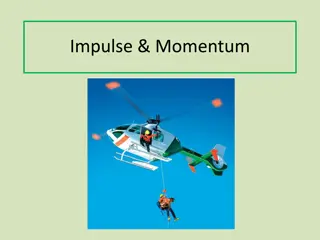Understanding Conservation of Momentum in Physics
Conservation of momentum is a fundamental law stating that momentum is conserved in a closed system where it is neither created nor destroyed, but rather transferred between objects. This principle is applied in various scenarios, such as bullet-gun recoil, collision of objects, and more, to determine velocities and directions post-interaction.
Download Presentation

Please find below an Image/Link to download the presentation.
The content on the website is provided AS IS for your information and personal use only. It may not be sold, licensed, or shared on other websites without obtaining consent from the author. Download presentation by click this link. If you encounter any issues during the download, it is possible that the publisher has removed the file from their server.
E N D
Presentation Transcript
Its the Law! Momentum is neither created nor destroyed, only transferred from one object to another OR The total momentum of a closed system is a constant OR pi= pf
Start with pi= pf For each side, include a term for each separate object Each term is mv use subscripts to tell them apart
Sample Problem 1 A bullet of mass 0.050 kg leaves the muzzle of a gun of mass 4.0 kg with a velocity of 400 m/s. What is the recoil velocity of the gun?
Sample Problem 1 Solution mvbgi=mvbf+mvgf 0=(.050kg)(400m/s)+(4.0kg)vgf vgf= -5.0 m/s
Sample Problem 2 A model railroad engine of mass 1.0 kg and a speed of 2.0 m/s collides with an identical engine which is at rest. On colliding, the two engines lock together and move away. What is the velocity of the two after the collision?
Sample Problem 2 Solution mvAi+mvBi=mvABf (1.0kg)(2.0m/s)+0=(1.0 kg+1.0 kg)vABf vABf=1.0m/s
Sample Problem 3 A skater with a mass of 60.0 kg is moving at 3.0 m/s to the right. Another skater of mass 40.0 kg is moving at 4.0 m/s to the left (negative 4.0 m/s). They collide and grab onto each other for support. What is their velocity and direction after the collision?
Sample Problem 3 Solution mvAi+mvBi=mvABf (60.0kg)(3.0m/s)+(40.0kg)(-4.0m/s) =(60.0 kg + 40.0 kg) vABf vABf=.20m/s (right)
Sample Problem 4 A 25.0 kg cart moves to the right at 5.00 m/s. It overtakes and collides with a 35.0 kg cart moving to the right at 2.00 m/s. After the elastic collision, the 25.0 kg cart slows to 1.50 m/s. What is the final velocity of the 35.0 kg cart?
Sample Problem 4 solution mvai+ mvbi= mvaf+ mvbf (25.0kg)(5.00m/s) + (35.0kg)(2.00m/s) = (25.0kg)(1.50m/s) + (35.0kg)vbf 195 kgm/s = 37.5 kgm/s + (35.0kg)vbf vbf= 4.5 m/s
Sample Problem 5 A bomb with a mass of 8.0 kg explodes and breaks into two large fragments. The first piece has a mass of 3.0 kg and moves to the left at 10.0 m/s. How fast must the other piece be moving?
Sample Problem 5 Solution mvABi=mvAf+mvBf 0=(3.0kg)(-10.0m/s)+(5.0kg)(vB) vBf=6.0m/s
Sample Problem 6 A lumberjack standing on a log floating in calm water, begins to walk along the log toward the east at 1.5 m/s. The lumberjack has a mass of 85 kg (and he s okay, for all you Monty Python fans), and the log has a mass of 145 kg. How fast will the log move?
Sample Problem 6 Solution mvABi=mvAf+mvBf 0=(85kg)(1.5m/s)+(145kg)vBf vBf= -.879m/s (west)
Sample Problem 7 During a snowball fight, a little girl of mass 14.6 kg is moving across nearly frictionless ice at 3.0 m/s when a 0.40 kg snowball moving at 15 m/s hits her in the back and sticks. How fast is she now moving along the ice?
Sample Problem 7 Solution mvAi+mvBi=mvABf (14.6kg)(3.0m/s)+(.40kg)(15m/s)= (14.6 + 0.40 kg)vABf vABf=3.3m/s
Sample Problem 8 At the ice show, a 75 kg clown is skating along at 3.0 m/s to the right while holding a 25 kg clown in his arms. He suddenly throws the little clown ahead of him. After the toss, the big clown is now moving at -1.0 m/s (that is, to the left). How fast is the little clown skating along the ice?
Sample Problem 8 Solution mvABi=mvAf+mvBf (75 kg + 25 kg)(3.0m/s)= (75kg)(-1.0m/s)+(25kg) vBf 375kgm/s=25kg vBf vBf=15m/s
Back to Unit 5 again Newton s 3rdLaw every action force has an equal and opposite reaction force That s another way of saying conservation of momentum: mvai+ mvbi= mvaf+ mvbf mvai- mvaf= mvbf mvbi - pa= pb -Fta= Ftb -Fa= Fb the forces are equal and opposite!
Elastic and Inelastic Collisions Perfectly elastic collisions collisions in which the objects rebound perfectly with no loss of EK Ideal situation! Perfectly inelastic collisions the objects stick together always some EK loss because of shape change
Most Collisions Are somewhere in between the objects don t stick, but they don t bounce off perfectly either Coefficient of restitution helps quantify how elastic the collision is























